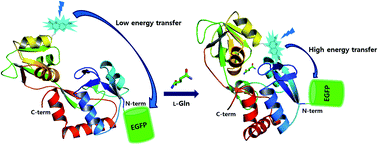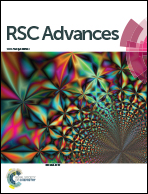Genetically encoded FRET sensors using a fluorescent unnatural amino acid as a FRET donor†
Abstract
FRET sensors based on fluorescent proteins have been powerful tools for probing protein–protein interactions and structural changes within proteins. However, they are intrinsically limited by their large size and the requirement for N- or C-terminal fusions. In this report, a FRET-based sensor was developed by incorporating a fluorescent unnatural amino acid into glutamine-binding protein (GlnBP), which formed a FRET pair with green fluorescent protein (GFP). GFP was fused to the N-terminus of GlnBP, and the fluorescent unnatural amino acid was incorporated into the site for N138 in GlnBP. FRET sensors were tested that contained linkers of different length between GFP and GlnBP, and assay conditions were optimized by changing the pH and salt concentration of the assay buffer. Under optimal conditions, the best sensor protein produced a 1.9-fold increase in the FRET ratio upon L-Gln binding, whereas either no change or minimal change was seen using other amino acids, including the other 19 natural amino acids and D-Gln. This novel design strategy for FRET sensors overcomes the limitations of current FRET sensors, which require the use of two fluorescent proteins. Consequently, our strategy may prove useful for investigating protein–protein interactions and for probing changes in protein conformation.


 Please wait while we load your content...
Please wait while we load your content...